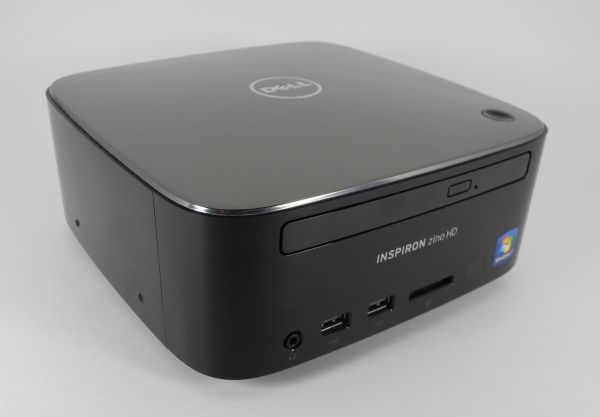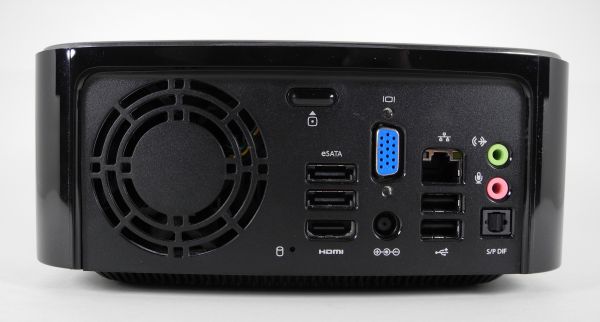Dell Zino HD 410 HTPC Review
by Ganesh T S on February 19, 2011 7:08 AM EST- Posted in
- HTPC
- Dell
- AMD
- Media Streamer
- ATI
Unlike the ASRock Core 100 / Vision 3D, the Zino 410 HD ships with a wireless keyboard and mouse. The packaging is, therefore, appropriately bigger. Apart from the main Zino 410 unit, the package also contains:
- 90W AC / DC Adapter
- Wireless keyboard and mouse with batteries
- USB RF receiver for the wireless keyboard / mouse
- Media Center remote
- Black lid (to replace the silver lid present on top of the unit by default)
- Support CD and warranty information booklet
Of all the SFF HTPCs I have seen, the Dell Zino 410 HD HTPC has the best industrial design. The contours are quite pleasing and the unit blends in quite nicely with the rest of the AV equipment.
The front panel is taken up by a tray loading Blu-Ray drive on top and a headphone jack, couple of USB 2.0 ports, SD card reader and the IR receiver at the bottom. The power switch is on the top panel.
The left half of the rear panel is taken up by the cooling fan. A press switch to displace the lid is provided at the top and a hard drive activity light is at the bottom. Other ports on the rear panel include 2 eSATA, 1 HDMI 1.3a, 1 VGA, 1 Gigabit Ethernet jack, 2 USB 2.0, a mic/headphone jack, optical SPDIF and the power adaptor connector.
The Zino 410 HD is raised with rubber bushes, and also has ventilation slots on all four sides, as can be seen in the picture above.
Just like a notebook, this unit also supports simultaneous display on two monitors. Testing was done mostly with the HDMI output connected to a Toshiba REGZA 37" 1080p TV through an Onkyo TX-SR 606. For non-media playing related testing, the VGA port was connected to an Acer H243H 1080p monitor.
Our review unit shipped with Windows 7 x64 Home Premium and a OEM version of Cyberlink PowerDVD for Blu-Ray playback.
We will conclude this section with a table to summarize the data and A/V connectivity options for the Zino 410 HD HTPC.
| Option | Status |
|---|---|
| HDMI | Yes [v1.3] |
| Component | No |
| Composite | No |
| VGA | Yes |
| SPDIF | Yes [Optical] |
| Stereo | Yes |
| Option | Status |
|---|---|
| Optical Disk Drive | Yes [Blu-Ray / DVD-RW] |
| USB | Yes [4 x v2.0] |
| eSATA | Yes [2x] |
| LAN | Yes [ 1000 Mbps GbE ] |
| Internal HDD | Yes [ 750 GB ] |
| WiFi | Yes [ 300 Mbps 802.11n ] |
| Card Reader | Yes |













69 Comments
View All Comments
strikeback03 - Tuesday, February 22, 2011 - link
The largest PicoPSU I see advertised is a 150W model, which claims 8A/96W of 12V power available. Trying to run a ~60W TDP video card and a 95W TDP processor off that sounds like a bad ideapirspilane - Sunday, February 20, 2011 - link
Did HDMI handshake problem occur in your testing of the ASRock Core100 HT? If so, how can it be fixed?I have a Core100, and have experienced loss of HDMI audio whenever the connection with my Denon AVR is interrupted. Example, I switch the AVR to a different input, when I switch back to the Core100 input, audio is gone, but video is still there.
My PS3 has no problems with this, although there is a several second period before audio is re-established. Anyone else had a problem with a Denon/Core100 setup?
ganeshts - Monday, February 21, 2011 - link
No handshake issue with an Onkyo 606. I don't have a Denon myself.. hopefully some other reader can chime in.By the way, you have a higher probability of finding someone with your setup on AVSForums (There is a dedicated thread for Core100 IIRC) :)
Ganesh_balan - Sunday, February 20, 2011 - link
"A press switch to displace the lid is provided at the top and a Kensington lock slot is at the bottom."Doesn't look like the Kensington lock to me but the hard drive activity indicator. :)
Please re-check! :D
ganeshts - Monday, February 21, 2011 - link
Thanks! Fixed ( was writing another review concurrently and this got mixed up :| )brucek2 - Monday, February 21, 2011 - link
What types of content are typically 1080p60? I had thought most movies were 24fps and most tv shows were 30fps. I'm trying to understand how big a limitation the lack of 1080p60 is likely to be?ganeshts - Monday, February 21, 2011 - link
Camcorders are one of the main sources of 1080p60 content.Some camcorders which record at 1080p60 are: Sanyo HD2000 and Panasonic TM700. There are some other models from the 2 companies which are also 1080p60, but I don't remember offhand.
In addition, user created videos can also be encoded on a PC at 1080p60.
sicofante - Monday, February 21, 2011 - link
Industrial designers must be really expensive to be out of reach for Dell...Why is it that only Apple takes care of the looks of their hardware? It really puzzles me.
This thing is so ugly only true geeks would have it in their living rooms.
myangeldust - Saturday, September 10, 2011 - link
I push mine further back in the TV cabinet. It's all black so it dissappears in the shadows. Like that R2 unit with poorly matched color panels it knows it's ugly so stays in the background and doesn't complaints.cjs150 - Monday, February 21, 2011 - link
I agree with the comment about looks. Apple designs things that look pretty, the Dell looks like cheap plastic.Despite this why are getting close to an ideal HTPC. I know this is subjective but the ideal HTPC should be:
1. Silent (or as close as possible, I do not want to hear it in a quiet bit of a movie)
2. Audio should be capable of being sent through HDMI in all formats my AV receiver can cope with, but with option to use other connectors (some people prefer)
3. Plays all mainstream formats.
4. Has a TV receiver card (here in UK would be nice if it could replace my cable box but I doubt supplier will ever agree)
5. IR receiver
We are very close to ticking all the boxes. Still think it should have an SSD and a 2,5" HD (maybe SSD could replace the wireless card in the mini-PCI slot as my house is fully wired)
Only one issue for me on the thermals of this box, and maybe I missing something but...
The Dell Zino is obviously designed for sitting horizontally on something (why else have the feet on the bottom). Heat rises. To make ideal use of convection therefore the top should be perforated (a mesh would be ideal) to let heat escape and the sides perforated to allow cooler air to replace the hot air leaving the top. (this is not exactly rocket science is it!) So why on earth do designers place the optical drive at the top blocking a large amount of area where the heat would escape. Surely it is more sensible to have the optical drive (and 2.5" HD or SDD) underneath the motherboard.
What am I missing - someone please explain